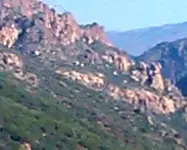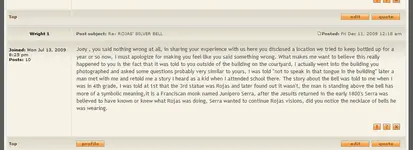Another long winded one - extra coffee alert
I have noticed that the 1707 map by Padre Kino only shows one Mountain in the middle of the Superstition Mountains with a black sombrero with a heart on the east side of that mountain, between the Salt and Gila Rivers. On the south bank of the Gila River is a Pyramid called Cala Grande.
Doesn't anyone know about the Chimera and Orb? They are in my actual photo I took in MY Hunt posted here.(taken while I was on the trail)
The Chimera and Orb are new to me - can't say I have run across it before.
Don Jose, suerta de dueno el Real de Tayopa wrote
Fellow coffee slurpers and addicts: First, I would like you to clarify just what would be considered a large treasure in 'those' days, not our present, extremely inflated, values.
50 centavos was considered a normal monthly wage in the 1800's, in the 1500's ?
By that standard then, even the meager 250 pesos stipend living allowance granted to the Franciscan padres in Alta California, was impressive? I must respectfully disagree on this amigo, to a degree; look at what father Segesser complained of, having to pay 700 to 800 dollars to hire a field manager for a year, which was more than his own pay. This is far more than fifty centavos a month, which amounts to only six pesos (or dollars) per year.
Don Jose el Tropical Tramp also wrote
Second, Yes the various missions did mine, a conspicuous example was Baroyeca in Sonora. Check on it.
True however a key search phrase to watch for, which took me some time to look for was a "mining mission". It does not occur often and I read past it repeatedly before picking up on it. Baroyeca is one of this type of mission, in fact I am certain it was classed as such.
Don Jose el Real de Tayopa also wrote
Third, I disagree with my normally infallible ORO in that while the mission Priest did normally have full control of his area, he always was subject to higher authority sent by Rome on mining matters, or 'any' subject in furthering the Jesuit society.
Remember. They were originally a Military order, and as such the area commander is always subject to higher command. <snip>
I must agree in part, and respectfully disagree in part. No argument that the Jesuits had and still have a well defined chain of command, and that padres stationed at various missions (which often had satellite visita type mission) had to answer to those higher in rank, however each padre was fully in charge of all operations of commerce in his mission where it pertained to the Indians. The Indians had a legal standing similar to that of minors today, not considered as "adults" able to conduct their own businesses, thus the padres had to act as the "legal guardians" of the Indians, especially since the Indians owned nothing.
Don Jose' le gringo de la Mancha also wrote
As for Jesuit mining openly in South America, but supposedly not in North America, this was due entirely to the rulings of the council of the Indies who were the direct representatives of the King , they made the rules and advised him directly.
Why the two different groups had such divergent basic ideas on the Mining is questionable. For example why did the king order against mining, not once but various times when the Jesuits were freely mining everywhere else in the known world except North America, and continued to do so ?.
I would suggest perhaps a re-read of the Royal edicts concerning religious operating mines amigo, which was openly flaunted by not just the Jesuits but apparently almost all Orders including nuns had a hand in it, in one way or another. I do not have them at hand, but think the orders may have applied to all of Spanish America, perhaps even in the Philippines.
I look forward to the rest of your post,
Oroblanco




 I doubt, in 1959, the builders found engraving Father Serra's name in the statue was necessary.
I doubt, in 1959, the builders found engraving Father Serra's name in the statue was necessary. 


 good one.
good one.

